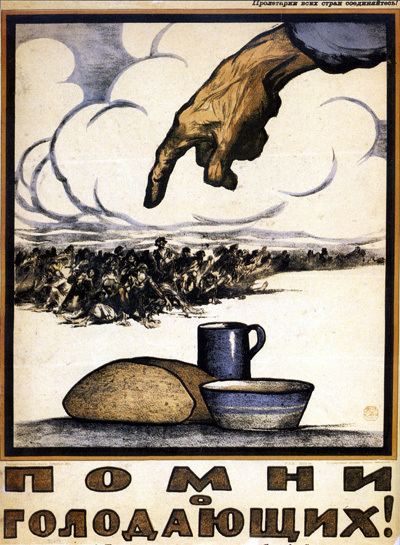 | ||
Throughout Russian history famines and droughts have been a common feature, often resulting in humanitarian crises traceable to political or economic instability, poor policy, environmental issues and war. Droughts and famines in Russia and the Soviet Union tended to occur fairly regularly, with famine occurring every 10–13 years and droughts every 5–7 years. Golubev and Dronin distinguish three types of drought according to productive areas vulnerable to droughts: Central (the Volga basin, North Caucasus and the Central Chernozem Region), Southern (Volga and Volga-Vyatka area, the Ural region, and Ukraine), and Eastern (steppe and forest-steppe belts in Western and Eastern Siberia, and Kazakhstan).
Contents
Pre-1900 droughts and famines
In the 17th century, Russia experienced the famine of 1601–1603, believed to be its worst as it may have killed 2 million people (1/3 of the population). Major famines include the Great Famine of 1315–17, which affected much of Europe including part of Russia. The Nikonian chronicle, written between 1127 and 1303, recorded no less than eleven famine years during that period. One of the most serious crises before 1900 was the famine of 1891–92, which killed between 375,000 and 500,000 people, mainly due to famine related diseases. Causes included a large autumn draught resulting in crop failures. Attempts by the government to alleviate the situation generally failed which may have contributed to a lack of faith in the Czarist regime and later political instability.
List of post-1900 droughts and famines
The Golubev and Dronin report gives the following table of the major droughts in Russia between 1900 and 2000.
1900s
The failed Revolution of 1905 likely distorted output and restricted food availability.
1910s
During the Russian Revolution and following civil war there was a decline in total agricultural output. Measured in millions of tons the 1920 grain harvest was only 46.1, compared to 80.1 in 1913. By 1926 it had almost returned to pre-war levels reaching 76.8.
1920s
The early 1920s saw a series of famines. The first famine in the USSR happened in 1921–1923 and garnered wide international attention. The most affected area being the Southeastern areas of European Russia (including Volga region, especially national republics of Idel-Ural, see 1921–22 famine in Tatarstan) and Ukraine. An estimated 16 million people may have been affected and up to 5 million died. Fridtjof Nansen was honored with the 1922 Nobel Peace Prize, in part for his work as High Commissioner for Relief In Russia. Other organizations that helped to combat the Soviet famine were International Save the Children Union and the International Committee of the Red Cross.
1930s
The second major Soviet famine happened during the collectivization in the Soviet Union, and critics of communism claim was artificially created to deal with Ukrainian resistance to Soviet occupant regime, saying it was an act of genocide. However, there is still issue over whether or not Holdomor was a massive failure of policy or an intentional act of genocide. Robert Conquest held the view that the famine was not intentionally inflicted by Stalin, but "with resulting famine imminent, he could have prevented it, but put “Soviet interest” other than feeding the starving first – thus consciously abetting it".
In 1932–33 confiscations of grain and other food by the Soviet authorities[1] contributed to the famine which affected more than forty million people, especially in the south on the Don and Kuban areas and in Ukraine, where by various estimates from 5 to 10 million may have starved to death (the event known as Holodomor). Estimates of deaths due to the 1932–1933 famine vary wildly, but are typically given in the range of millions. The long term demographic consequences of collectivization meant that the Soviet Union's 1989 population was 288 million rather than 315 million, a rate 27% lower than it otherwise would have been. About 200,000 Kazakh nomads fled to China, Iran, Mongolia and Afghanistan during the famine.
Although famines were taking place in various parts of the USSR in 1932–1933, for example in Kazakhstan, parts of Russia and the Volga German Republic, the name Holodomor is specifically applied to the events that took place in territories populated by ethnic Ukrainians.
1940s
During The Siege of Leningrad as many as one million people died while many more went hungry or starved but survived. Starvation was one of the primary causes of death as the food supply was cut off and strict rationing was enforced. Animals in the city were slaughtered and eaten. Instances of cannibalism were reported.
The last major famine in the USSR happened mainly in 1947 as a cumulative effect of consequences of collectivization, war damage, the severe drought in 1946 in over 50% of the grain-productive zone of the country and government social policy and mismanagement of grain reserves. The regions primarily affected were Moldova and South Western Ukraine. Between 100,000 and one million people may have perished.
1947-1991
There have been no major famines after 1947 despite issues with food security in the USSR and its successor states. The drought of 1963 caused panic slaughtering of livestock, but there was no risk of famine. Since that year the Soviet Union started importing feed grains for its livestock in increasing amounts.
Post-Soviet Russia
Since the collapse of the USSR there have been occasional issues with hunger and food security in Russia. In 1992 there was a notable decline in calorie intake within the Russian Federation. Both Russia and Ukraine have been subject to a series of severe droughts from July 2010 to 2015. The 2010 drought saw wheat production fall by 20% in Russia and subsequently resulted in a temporary ban on grain exports.
